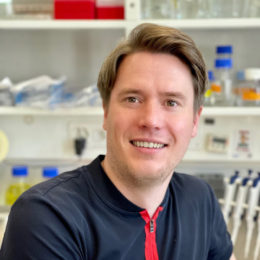About Andreas Boland
The Boland lab works at the intersection of Structural Biology, Molecular & Cell Biology and Chemical Biology. They leverage the latest developments in cryogenic electron microscopy (cryoEM) and use complementary biophysical techniques (proteomics, light-microscopy, microfluidics, etc.) to understand the molecular mechanisms that underlie cell cycle regulation as well as signal transduction by membrane proteins in health and disease.
Orderly progression through the cell cycle is arguably one of the most fundamental tasks in the life of a cell and must be tightly regulated. First, the DNA is replicated and the resulting sister chromatids are glued together by a ring-shaped protein complex called cohesin. The duplicated sister chromatid pairs then migrate to the equatorial plane of the cell. Separase, a cytosolic protease cleaves the cohesin ring and thereby enables sister chromatid dissolution during metaphase-to-anaphase transition. As a consequence, chromosome segregation to the opposite poles of a cell occurs before cell division. Activating separase at the wrong time in the life of a cell is unsafe and can lead to genomic instability, aneuploidy and eventually results in tumorigenesis.
In a second line of research, Boland lab is developing novel ligands that bind the µ-opioid receptor (µOR) to control downstream signalling. The μOR is the molecular target of opioid pain medicine such as morphine and fentanyl, however, due to the severe side effects, there is considerable interest in developing novel modulators. Recently biologics, including antibodies and nanobodies, have emerged as promising alternative therapeutics. Future work will include the design of nanobody-based modulators that show reduced side effects such as addiction, constipation and respiratory depression.
Andreas Boland completed his PhD at the Max Planck Institute for Biology in Tübingen in the group of Elisa Izaurralde where he discovered his passion for Structural Biology. He moved for his PostDoc to Cambridge and joined David Barford at the MRC-LMB. Here, he used cryoEM to investigate the structure & function of proteins involved in cell cycle regulation. He continues to work on important cell cycle regulatory proteins at the University of Geneva. Main techniques used to address biological questions are in vitrobiochemistry, structural biology and cell biology.
Contact
- Boland lab’s research website
- Follow Boland lab’s twitter account
- E-mail: andreas.boland@unige.ch

